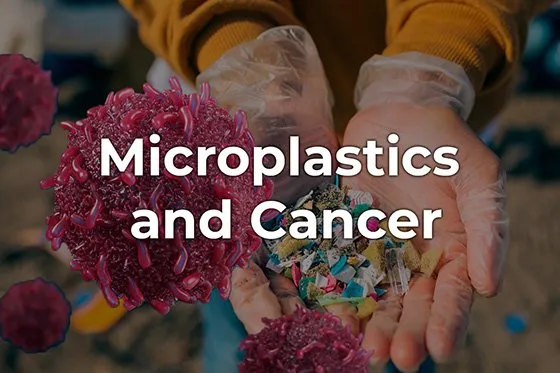We are surrounded by plastic. We use it, we discard it… and without realizing it, we inhale it, eat it, and absorb it through our skin. What concerns scientists today isn’t just the visible waste—the bottles or bags we throw away—but the microscopic fragments they break into: microplastics and nanoplastics. These particles are so small they can travel through the air we breathe, pass through the lining of our gut, cross the placenta, and even reach the brain. According to recent studies, their presence in the human body is not only widespread—it may be far more harmful than previously thought, potentially contributing to the development of various types of cancer.
A recent article published in Molecular Cancer (Deng et al., 2025) raises a red flag about the role these invisible contaminants could play in the onset of diseases such as breast, liver, and lung cancer, and even leukemia. These micro(nano)plastics, once inside the body, don’t just pass through unnoticed—they interact with our cells, with our immune system, and with the delicate balance that keeps our tissues healthy. Surprisingly, though, the same article also suggests that the very properties that make microplastics so dangerous might be repurposed to fight cancer, through highly innovative therapeutic applications.
How can micro(nano)plastics promote cancer?
Micro(nano)plastics behave silently but dangerously within the human body. Because of their ultrafine size, they can infiltrate organs and even penetrate individual cells. Once inside, they can disrupt normal biological processes in several ways. One key mechanism is chronic inflammation. As the immune system recognizes these particles as foreign invaders but is unable to eliminate them, it maintains a state of persistent immune activation. This chronic inflammation damages nearby tissues and creates an environment conducive to cancer initiation.
In parallel, microplastics trigger oxidative stress, an imbalance in cellular metabolism that leads to the overproduction of reactive oxygen species (ROS). These highly reactive molecules can damage cellular components, particularly DNA. If the resulting genetic damage isn’t properly repaired, mutations can accumulate, setting the stage for malignant transformation.
Additionally, many microplastics carry chemical additives such as phthalates and bisphenols, known endocrine disruptors. These substances mimic or interfere with hormonal signals, especially estrogen and androgen pathways, which are crucial in cancers like breast and prostate cancer. Moreover, microplastics can act like tiny “sponges,” absorbing environmental toxins—including heavy metals and polycyclic aromatic hydrocarbons (PAHs)—and transporting them into the body. Once released into tissues, these compounds can further increase the risk of DNA damage, hormonal imbalance, and tumor formation.
In summary, microplastics don’t just travel through our bodies—they interact, accumulate, and disrupt. They contribute to a cascade of cellular stress, genetic instability, and immune dysfunction that together heighten the risk of cancer.
What if plastic could also save us?
Here lies the paradox: what now appears to be a serious health threat might, in a different form, become part of the solution. Scientists are developing biocompatible, engineered micro- and nanoparticles that mimic the size and structure of environmental microplastics, but with one crucial difference—they’re designed for good. These particles can serve as smart drug delivery systems, capable of transporting chemotherapy or immunotherapy agents directly to the tumor, with precision and minimal damage to healthy tissues.
These engineered nanoparticles can be customized in size, shape, surface chemistry, and even electrical charge. Some are designed to remain stable in the bloodstream, but break down in the acidic environment of a tumor, releasing their therapeutic cargo exactly where it’s needed. Others are coated with molecules that allow them to recognize and bind specifically to cancer cells. In preclinical models, these delivery systems have already shown great promise in improving drug targeting, reducing systemic toxicity, and increasing the overall efficacy of anticancer treatments.
Immunotherapy and microplastics: a promising combination
Perhaps the most exciting aspect of this new research is the potential of nanoparticles to enhance immunotherapy, one of the most revolutionary approaches to cancer treatment. The immune system is naturally capable of recognizing and destroying cancer cells, but tumors often find ways to evade immune surveillance. Here’s where engineered particles come in.
The article describes how nanoparticles can be used to deliver two immunostimulatory antibodies simultaneously—anti-PD1 and anti-OX40—directly into the tumor environment. This dual delivery enhances T cell activation, boosts immune memory, and leads to a more potent and sustained antitumor response. In other experiments, researchers have loaded nanoparticles with STING agonists, molecules that kick-start innate immune responses, or combined them with photodynamic therapy to make tumors more visible and vulnerable to immune attack.
These strategies don’t just aim to eliminate the tumor—they aim to re-educate the immune system to recognize cancer as a lasting threat and respond accordingly.

Figure 1. Illustration of the main exposure routes to microplastics and their impact on the human body. Once inside, these particles can accumulate in various organs and trigger processes such as inflammation, DNA damage, and hormonal disruption, promoting tumor progression and altering the tumor microenvironment.
What lies ahead—and what can we do now?
While the therapeutic potential of nanoparticle-based strategies is rapidly evolving, we must not lose sight of the urgent concern: microplastics are already present in our bodies and ecosystems, and their harmful effects are becoming increasingly evident. Their link to chronic inflammation, hormonal interference, DNA damage, and immune disruption places them at the center of a growing public health challenge.
Still, research into biomedical applications is advancing with encouraging results. By understanding how these particles interact with our biology—for better or worse—we move closer to harnessing their unique properties for targeted, personalized cancer treatment.
The takeaway is both cautionary and hopeful: microplastics are no longer just environmental waste. They are inside us, interacting with our biology in ways we’re only beginning to understand. The challenge now is to mitigate their harm—and perhaps, in the process, turn them into allies in the fight against cancer.
Main Reference:
Deng, X., Gui, Y. & Zhao, L. The micro(nano)plastics perspective: exploring cancer development and therapy. Mol Cancer 24, 30 (2025). https://doi.org/10.1186/s12943-025-02230-z
Other References:
Wang, X., Xing, Y., Lv, M., Zhang, T., Ya, H., & Jiang, B. (2022). Recent advances on the effects of microplastics on elements cycling in the environment. The Science of the total environment, 849, 157884. https://doi.org/10.1016/j.scitotenv.2022.157884
Zhao, B., Rehati, P., Yang, Z., Cai, Z., Guo, C., & Li, Y. (2024). The potential toxicity of microplastics on human health. The Science of the total environment, 912, 168946. https://doi.org/10.1016/j.scitotenv.2023.168946
Hirt, N., & Body-Malapel, M. (2020). Immunotoxicity and intestinal effects of nano- and microplastics: a review of the literature. Particle and fibre toxicology, 17(1), 57. https://doi.org/10.1186/s12989-020-00387-7


